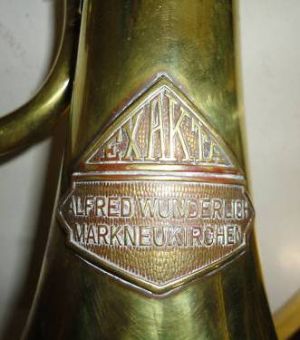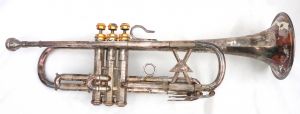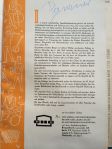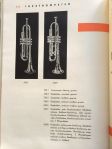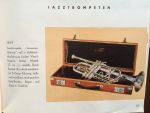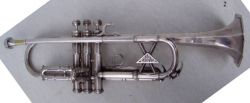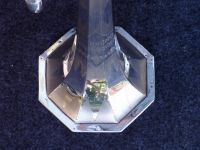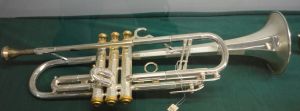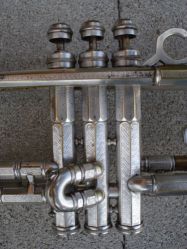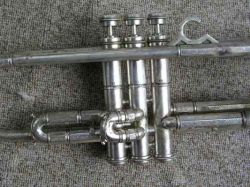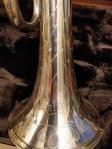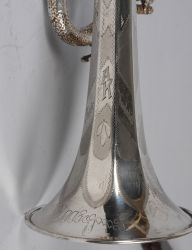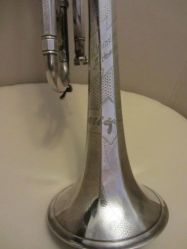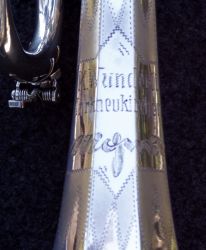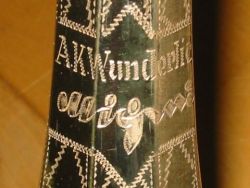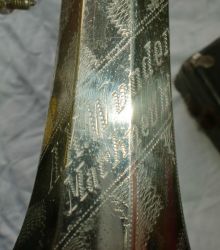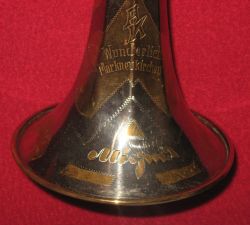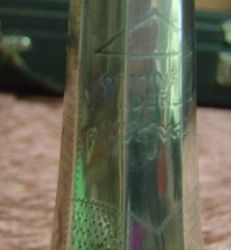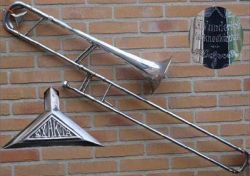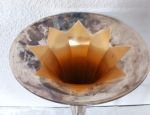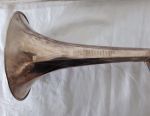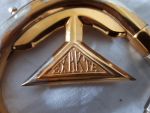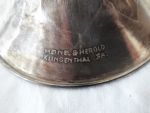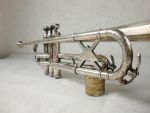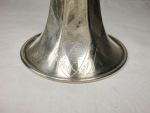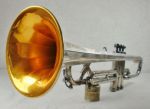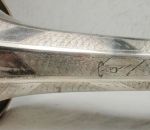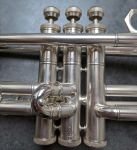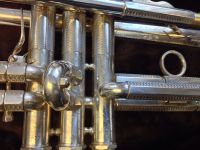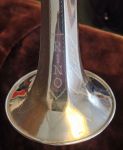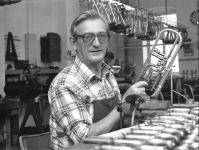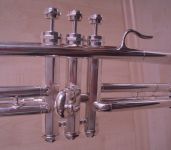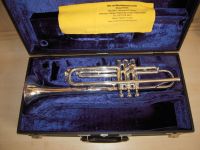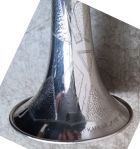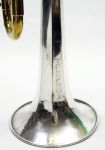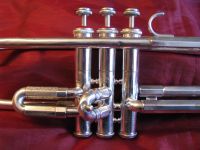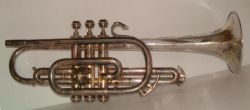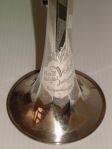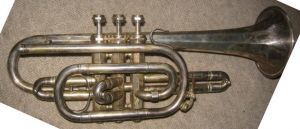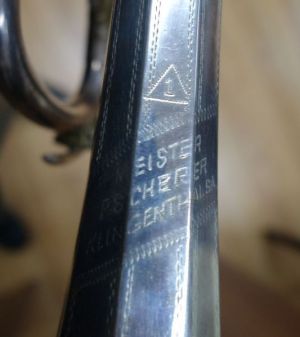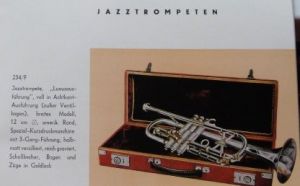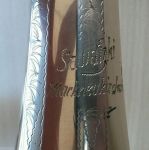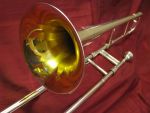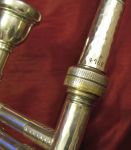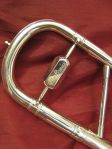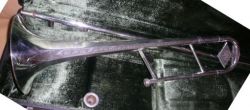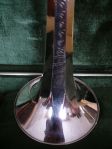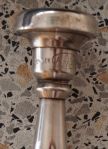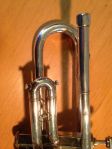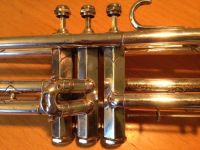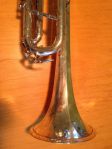Exakta
The Exakta is a type of Octagonal trumpets. From the forties till the seventies octagonal trumpets were made by GDR makers from Markneukirchen operating in the Sinfonia and Migma groups, like Kurt Knoth, A.K. Wunderlich and Johannes Scherzer. "This peculiar shape of brass instruments was interesting to show orchestra's. That was going on already in the 1940's", says museum direktor Heidrun Eichler from Markneukirchen.
The company A. K. Wunderlich in Markneukirchen was known for their 'Exakta' trumpets, but also build french horns and trombones. It was founded in 1907 by Alfred Wunderlich (26.05.1883 - 01.01.1969).
Contents
- 1 The Exakta and other octagonal bell trumpets from Markneukirchen
- 2 Wunderlich's Exakta
- 3 Migma & Sinfonia
- 4 Kurth Knoth, Johannes Scherzer
- 5 Alberto, Albert Wolfram Markneukirchen
- 6 Super
- 7 Horst Voigt, Markneukirchen
- 8 Joseph Pscherer
- 9 Erhard Sawatzki's dodecagonal trumpets
- 10 Otto Meinel
- 11 No names
- 12 The Arigra
- 13 Other trumpets with hexagonal valve casings
- 14 Sources
The Exakta and other octagonal bell trumpets from Markneukirchen
Brass instrument maker Mario Weller from Markneukirchen, who researches the history of 20th century brass instrument making in Vogtland, told me in March 2013: „Most of the brass instrument makers in the Vogtland made their octagonal bells out of standard bells, on their own rods. That's known for the workshops of Johannes Scherzer, A.K.Wunderlich and for the 12-sided version that came from the workshop of Erhard Sawatzki. The basic bells for all three workshops came from bell maker Heinz Nürnberger, formerly Firma Ernst Dölling, Markneukirchen. Heinz Nürnberger is known to have had his own 8 sided rod, that he lent to another Sinfonia member (Otto Meinel) when needed. Also known is that around 1950 instrument and bell maker August Reichel jun. made octagonal bells and sold them to Vogtlandian instrument makers.
Wunderlich's Exakta
The company A. K. Wunderlich in Markneukirchen was known for their 'Exakta' trumpets, but also build french horns and trombones. It was founded in 1907 by Alfred Wunderlich(26.05.1883 - 01.01.1969). His father and brother were both active as brass instrument makers. Alfred joined with this brother under the name „Gebr. Wunderlich“. Around 1938 his son Kurt Wunderlich (16.05.1908 - 10.05.1994) became his partner, hence the name A. K. Wunderlich ('A' for Alfred, 'K' for Kurt). In the shop at Mosenstraße 10 they had up to 6 people working. Many apprentices were trained, some of whom continued their craftsmanship in a workshop of their own. The company was dissolved in 1990.
Already before WWII Alfred Wunderlich built a trumpet with hexagonal valve casings. It already has the Exakta logo to it.
Alfred Wunderlich Exakta trumpet with hexagonal valve casings, source Ebay.de 2020
Most of their octagonal trumpets were build from 1945 till ca. 1970/75, After that interest strongly declined.
Here's an Exakta, A.K. Wunderlich, with the caracteristic triangular spin that also is found on Sinfonia instruments, and gold lacquered valve caps and bottoms. The inside of the bell is also gold lacquered.
Catalog "Alles für den Musikfreund', GHG Möbel- und Kulturwaren Bezirk, Karl-Marx-Stadt, Klingenthal
This Wunderlich Exakta is listed in a 1961 catalog from the Grosshandelskontor für Möbel-und Kulturwaren from 1961. It comes in three versions, with only the bell octagonal, bell and valve block octagonal and a fully octagonal one (except tubes). In a 1962 pricelist it's offered for (DDR) DM 275, DM 365 and DM 400 for the luxury version. Here's another Exakta, with an octagonal bell rim.
A double-braced Exakta
Wunderlich made these octagonal bell trumpets with hexagonal shaped valve casings but also with round valve casings. Hammered tubes are found on a lot of these trumpets, others are engraved.
He also made trumpets with hexagonal valve casings and a round bell. Here's an Exakta with the name Weltton on the bell. The Weltton ('world sound') brand was used between ca. 1953 and 1977.
The bell engravings also vary to quite some extent. AK Wunderlich and Markneukirchen and/or Migma are common. There's also an 'Originel Wunderlich'.
Wunderlich also made Exakta octagonal trombones with double braces.
Exakta trombone, engraved Meinel & Herold Klingenthal, source: Ebay.de 2017
Exakta trombone, source: Ebay.de 2024
Migma & Sinfonia
Musical instrument makers around Markneukirchen were organised in cooperatives, for the purchase of materials and selling of products. Wunderlich was member of Migma, an acronym for "Musikinstrumenten Genossenschaft Markneukirchen", a cooperative with at a time several hundred musical instrument makers, established in 1943 and still existing. Other workshops were organised in Sinfonia, a production cooperative (PGH, Produktions Geselschaft) that existed as of 1960. In the seventies, wenn it became clear that with export of hand made instruments foreign currency could be acquired, the PGH Sinfonia was transferred into a 'Volkseigene Betrieb' (VEB Sinfonia), a state organisation. In 1984 the VEB SINFONIA became VEB Blechblas- und Signalinstrumentenfabrik Markneukirchen. In 1990 VEB B & S became the Vogtländische Musikinstrumentenfabrik GmbH (VMI).
Members of PGH Sinfonia were amongst others Johannes Scherzer, who in 1961 took over the workshop of his uncle Kurt Knoth (both using the tradename 'Rino'), Karl Mönnich, Albert Wolfram, Otto Meinel, Walter Mönnig, Erhard Sawatzki as well as the Philipp Reichel workshop with his 'subdivisions' Armin Glier and Klaus Wolfram.
Kurth Knoth, Johannes Scherzer
The workshop of Kurth Knoth and his successor (and nephew) Johannes Scherzer made several hundreds of octagonal trumpets, according to Mario Weller. Kurth Knoth took over the Rino workshop from his father Emil in 1935, and moved it to the Mosenstraße 13 in Markneukirchen. In 1961 Kurt Knoth who was a member of Migma, joined the PGH Sinfonia. As of 1961 Johannes Scherzer was in charge of the workshop. The Scherzer workshop then in 1984 became part of the VEB Blechblas- und Signalinstrumentenfabrik.
Here's an octagonal trumpet engraved Kurt Knoth Instr.Baumeister with trademark Rino and sold through Migma, with hammered tubing and gold wash bell. Dated 1940 -1950 by the 2014 Ebay seller, but as it's engraved Migma it can't be before 1943.
Here's a trumpet marked Rino on the spin and on the middle valve casing.
Rino trumpet, valves numbered 10, 11, 12
And a Rino octagonal trumpet with Sinfonia on the spin and Rino on the bell and pinky hook. As it's marked Sinfonia it must be later than 1960
Kurth Knoth Rino Sinfonia, valves numbered 37, 38 (2), 39 source Ebay.com 2015.
Here's another trumpet marked Scherzer, with octagonal valve casing, bottoms and caps, similar to those of the Kurth Knoth above. This one however has a hexagonal bell and hexagonal ferrules. It was offered on Ebay from 2014 till 2015 by instrument maker Simon Freyer in Friedrichsdorf, who believes it's a one off. The serial number is 4956, the valves are marked 37,38,39.
Scherzer hexagonal trumpet, serial number 4956, source Ebay 2014
As a side step, a no name trumpet that presumably also has it's origins in Markneukirchen. Some octagonal tubes, hammered bell, valves and other details hexagonal. On the bell: Musik Kapelle 'KVB' No 2. The seller suggests that it may have been playd in the orchestra of the Kölner Verkehrs Betriebe (the transport company of Cologne) .
Alberto, Albert Wolfram Markneukirchen
Albert Wolfram (+2007) who started his workshop in 1957 used the tradename Alberto. His son Gerhard Wolfram is the last known instrument maker in Markneukirchen still building octagonal trumpets.
And one more Wolfram, marked A. Wolfram and dated by de Ebay seller around 1975.
The octagonal trumpets of Albert Wolfram appear regularly at sites like Ebay.
Now here's a similar trumpet marked Meister K.Wolfram. The seller states the modelname is Jupiter. The seller of another K. Wolfram trumpet dates it around 1955.
|Meister K.Wolfram Sinfonia model Jupiter, marked D162 K.Wolfram Sinfonia, ca 1955
Super
An octagonal trumpet with a valve block similar to the above Wolfram appeared on Ebay in 2016. It has the name Super on it, a number (624?) on the valve block and no Sinfonia spin.
Horst Voigt, Markneukirchen
An octagonal cornet was signed by Horst Voigt, Markneukirchen. Horst Voigt (1920 - 1994) was educated at A.K. Wunderlich and opened his own workshop in 1951. In 1953 his many years younger brother Helmut joined him.
Another octagonal cornet that has octagonal valve caps and valve casings. No makers name, presumably older than the Horst Voigt cornet and definitely no Arigra as is suggested in it's ebay ad
Joseph Pscherer
Meister Joseph Pscherer was born in 1909 in Eibenberg (7km from Graslitz, now Czech). According to Mario Weller, he got his education in Graslitz and worked from 1953 till 1978/1980 in Klingenthal, 7 km from Graslitz on the German side of the border. He passed away around 1996. Pscherer always worked alone and had his instruments sold through the Migma collective, and incidentally also through PGH Sinfonia, as Weller states. This instrument has no reference to either Migma or Sinfonia.
Other workshops made octagonal trumpets under the Sinfonia name, some are only marked Sinfonia, without a maker. A 1961 GDR catalog shows an octagonal trumpet, in luxury version. It has gold lacquer in the bell and on the bows. The catalog ("Alles für den Musikkfreund") was issued by the Grosshandelskontor (GHB) für Kulturwaren in Karl-Marx-Stadt (now Chemnitz). The GHB was a new wholesale organisation in the socialist GDR that existed as of 1960.
Erhard Sawatzki's dodecagonal trumpets
Erhard Sawatzki (03.08.1924) was educated at the A.K. Wunderlich shop from 1939 till 1942 and worked there till April 1963. He worked as in independent instrument maker from 1963 till 1990, being a member of Sinfonia, where his workshop had the number 4, as a prefix to their serial number. He made trombones, trumpets, flugelhorns, cornets, tenor and french horns in different models, some 2000 instruments all together. His specialty were dodecagonal trumpets, with bell, valve caps and tubes 12-sided.
Here's a Sawatzki dodecagonal trombone, offered on Ebay in 2019. It's marked SAMA and Sinfonia and has number 4 162, so one of his earlier instruments.
Sawatzki trombone, sr.nr 4 162, source: for sale on Ebay.de in 2019 by dukakis1967
Sawatzki, like Wunderlich, also made octagonal trumpets and trombones.
Otto Meinel
The Markneukirchen brass instrument maker Otto Meinel (1909-1976) was self-employed from the mid-1930s until his death. He employed up to 4 people and also trained apprentices. From the beginning of 1962 he was a member of the production cooperative (PGH) "Sinfonia", before that he worked as a member of the Migma coöperation. The octagonal trumpet below is attributed to him by Mario Weller.
Octagonal trumpet, attributed to Otto Meinel, valve casings marked 52,53,54, coll. Dieter Grösche
No names
Then there are the unidentified octagonal trumpets. The first one is richly decorated. Valve caps hinting on Markneukirchen, as does the mouthpiece that goes with it (not necessarily original).
anonymous trumpet, mouthpiece marked SONDER A M Sch KLASSE, source Ebay.de 2016
The University of Edinburgh suspects it's octagonal trumpet to be 'possibly German, ca 1950'.
An octagonal bell trumpet with hexagonal valve block/caps/bottoms
The Arigra
Click on the following title for an overview of and the story behind the Arigra
Other trumpets with hexagonal valve casings
Click on the following title to view an overview of Other trumpets with hexagonal valve casings
Sources
- G.Dullat Der Musikinstrumentenbau und die Musikfachschule in Graslitz von den Anfangen bis 1945
- The New Langwill Index
- Ebay and the rest of the internet
